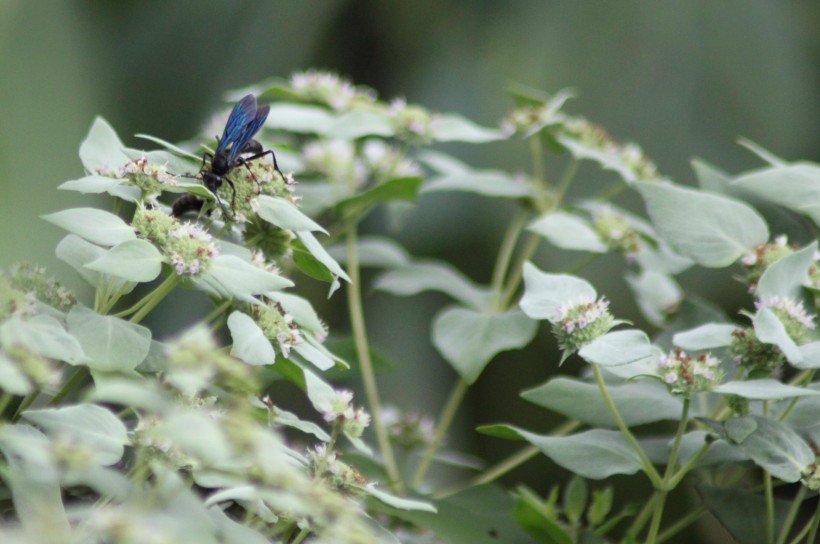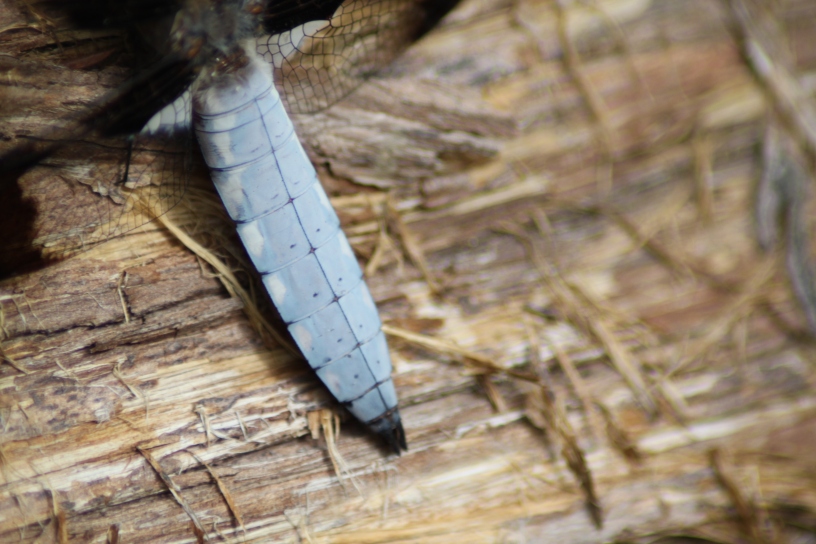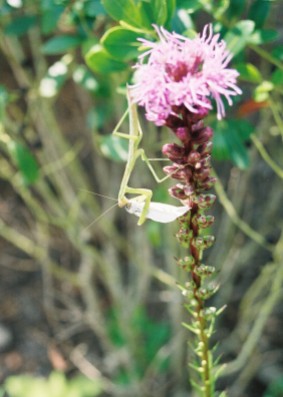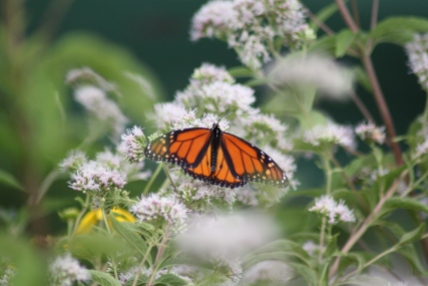
Ahh the Ladybug…Everyone’s Favorite Carnivorous Beetle
Over the past couple of weeks I have been noticing the insect life on the plants near me. So many times I interact with people interested in gardening for the beauty of the flowers and the value of vegetables for their dinner table. Little do they think about the value of the fruits of our garden to the smallest residents, the insects. Rarely, when they consider their newest plant for their garden do they consider the beauty of the bloom or the fragrance of the flower is meant to attract insects, and just happens to be appealing to us as well.
People get frustrated when caterpillars chew holes in leaves, when bees surround the flowers planted near walkways. But that is the purpose of the flowers. They are just doing their job! The same can be said for the insects. I run into students when I am teaching expressing grave concern regarding the bugs in their yard, asking what they can do to get rid of them. “Pave your yard“, is my internal answer. Not much thrives on asphalt. Being an educator, my actual answer is an explanation of the insect/plant connection and ultimately the insect/human connection. You know, how without insects, our lives would be much much harder. Really, you can’t have beautiful flowers without the bugs that go along with them.
It’s true, I don’t like them all either. Especially those insects from a foreign land here to eat my vegetables.
Rather than looking at insects as the creepy crawly things that have us running, arms flailing, screaming out of the garden, think of them as guests to the outdoor dinner party you created for them. Am I happy to see each and every insect in my yard? Nope. I will admit my recent frustration upon finding my first ever 4-lined plant bug in my small organic vegetable garden. And something has destroyed almost my entire crop of kale and collard greens. (And my silly chickens have eaten all the leaves off of my rhubarb plants, but that’s a different story. Why is it that the only critters that don’t seem to know rhubarb leaves are poisonous are my feathered ladies?) But as much as I hate to see this insect impacting the few cucumbers I can a mange to grow in my shady plot, I can still marvel at its beauty. And I can wonder at the skill of mother nature to have evolved such insects trained to seek out and find their specific crop.
My first introduction to the connection to the plants in my garden and the greater natural world around me wasn’t all that long ago. I was working around the yard and checking on a young red oak. A double row of perfectly shaped and perfectly spaced eggs on a small branch happened to catch my eye. What the heck are they? Where did they come from? How could they be so perfect? In trying to identify this insect I discovered two things. First, Googling “gray insects eggs in two perfect rows” might actually give you the right answer. Second, Garden Insects of North America by Whitney Cranshaw lives up to its subtitle: The Ultimate Guide to Backyard Bugs. If you have a yard, this book should be in your library. Turns out the eggs I found that day were katydid eggs. And further research on katydids taught me that their favorite place to hang out and sing their songs is in the canopy of White Oak trees, which we just happened to have in great numbers around our house. Katydids do eat leaves of most deciduous trees, but aren’t around in numbers great enough to cause much damage. Meanwhile they provide that summer evening sound we have come to expect in these parts creating the perfect soundtrack to the dancing lights of fireflies.
I get pretty excited when I witness a ‘new-to-me’ insect. Here a few I have found in the last couple of weeks.
Common Whitetail Dragonfly
Mosquito eater most welcome in my damp garden.
Meet the Neighbor:
This is a moth! Yes, it’s common name is The Neighbor. Moths aren’t all the sweater eating, frantic brown guys you see hanging out at your front porch light. Learn more about moths, their value and their amazing diversity by attending a National Moth Week event near you!

The Neighbor (Haploa contigua) on a dandelion leaf.
Milkweeds: Not just for Monarchs.
The sweet scent of milkweed flowers are enticing to more than just the orange and black monarch. Below a Swamp Milkweed Leaf Beetle explores the leaves of Common Milkweed. Common Milkweed often attracts another red and black beetle the Milkweed Bug, which seems to gather in large groups. The Swamp Milkweed Beetle seems to be a more solitary type of insect. The Swamp Milkweed Leaf Beetle will eat unopened flower buds as well as performing amazing feats of balance precariously perched on the edge of a milkweed leaf blade!

Swamp Milkweed Leaf Beetle (Labidomera clivicollis) on Common Milkweed (Ascelpias syriaca)
These eggs stink…but they’re pretty!
I am always fascinated by the beauty and symmetry of insect eggs. Here we have a clutch of Stinkbug (Euschistus spp.) eggs. They look alien with their silver enamel and protruding spikes.

Stinkbug Eggs on Persian Ironwood (Parrotia persica)
I also get pretty excited seeing the familiar insects we have all grown to love. Monarch Butterflies and Ladybugs both seem to have a special place in the hearts of nearly everyone. Even the most squeamish will allow the gentle explorations of a ladybug on their arm! Would they still if they knew the ladybug is a voracious hunter and eater of other insects, that it dines on aphids while still alive, stuffing them head first into their mouths? And you let THAT crawl on you but other bugs are just too gross? Really? Really! Let’s decide that we will appreciate all insects, not just the cute ones with harmless sounding names! Are you with me?!
I don’t like dill pickles…I like bugs!
I plant dill in my garden for only one reason – to attract insects. I can’t stand the smell or taste of dill. But I know it attracts all kinds of beneficial insects to the garden helping to keep harmful pests at bay and increasing the diversity and balance in my garden. Fennel works well too. And I love fennel. So I plant the dill for the caterpillars and hope they stay away from the fennel. This caterpillar seems to have similar tastes to mine.

Black Swallowtail (Papilio polyxenes) Caterpillar on Fennel (Foeniculum vulgare)
Spit on the plants… How Rude!
You all have probably seen this glob of what looks like spit on various types of plants. This is just the protective covering created by the Spittlebug (Philanaenus spumarius). According to my garden insects book the young spittlebugs produce these bubbles as they suck the sap from their plants. Air bubbles combine with excess fluids to create a mass of bubbles surrounding them and protecting them from predators. How cool! We, as humans, purchase all kinds of bubble making paraphernalia and equipment to surround ourselves with the delightful iridescent lighter-than-air spheres, and here is a tiny insect able to create its own bubble-filled world!

Spittlebug (well, its spit anyway…) on Oxalis.
This bug means business.
Just the name of the Great Black Wasp conjures up images of gore in the garden! But this beautiful insect with the iridescent blue wings is one you want to have around and keep around. This wasp saves her stings for katydids and other members of the cricket family. She uses her sting to catch prey for her carnivorous youth while she eats the nectar of nearby flowers, pollinating them as she goes along. Incidentally, just like the Oakleaf Hydrangea, a Bartram was the first to record an encounter with this insect back in 1749 making it the “first accepted account of a New World insect recorded by a New World scientist” according to the UWM Field Station Blog.

Great Black Wasp (Sphex pansylvanicus) on Mountain Mint (Pycnathemum muticum)
Praying for a meal.
If you have problem insects in your landscape, encourage the Praying Mantis to visit. They will eat the problem bugs, they’ll eat the good bugs (and almost anything else!) too so beware! You can purchase praying mantis egg cases many places, but it is always better practice to encourage the beneficial insects to show up on their own and then create a habitat where they can spend the rest of their life and create the next generation.
Monarchs…Not just for Milkweeds!
With all the talk about the decline of monarchs and milkweed in the news lately, many people are under the impression that milkweeds are the only thing that will attract monarchs to your yard. Not true! As adults, Monarchs are attracted to many types of flowers. However, to ensure the population of monarchs thrives, it is essential to provide a place where the adults can safely create the next generation and where the next generation has everything they need. The Monarch young NEED milkweed. A diverse landscape, be it wild or cultivated, is essential to provide for the needs of everything from the smallest insect to, well, us.
I think what I like best about looking for insects on plants is that appreciating them requires getting up close and personal with your plants. Perhaps, upon getting close, you notice the plant has a subtle fragrance you hand’t experienced before. You may notice small soft hairs on the stems or glittering reflections in the colorful petals. By spending the time investigating, you earn a bug’s eye view of the plant perhaps finding the world just a little more amazing and learning to appreciate the diversity a balanced landscape offers. So get in your garden or up close and personal with the plants of your wild spaces. Look into the tiny world of the minute. Get an understanding of your plants in the bigger picture. Try to get a bugs eye view of the world – you never know what fascinating creature will be looking back at you.












July 9, 2014 at 12:53 pm
I really like this. I would like to use some of it next year when I do the newsletter. Unfortunately this year’s FOLA newsletter is finished.
Alice
July 23, 2014 at 7:26 am
I am happy to contribute Alice!